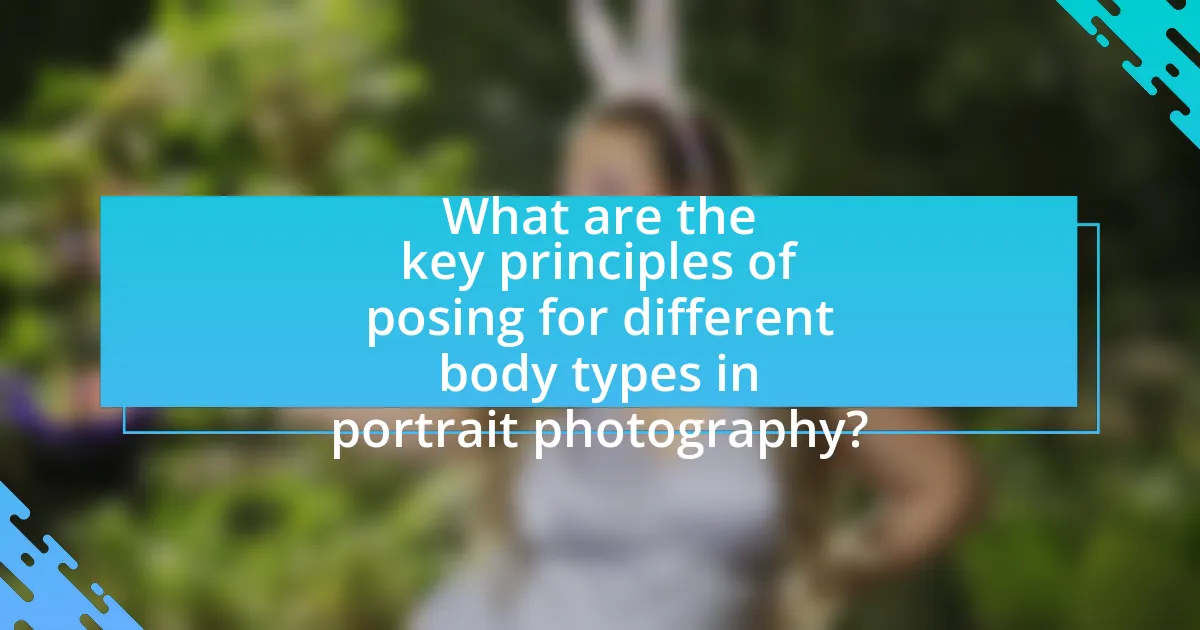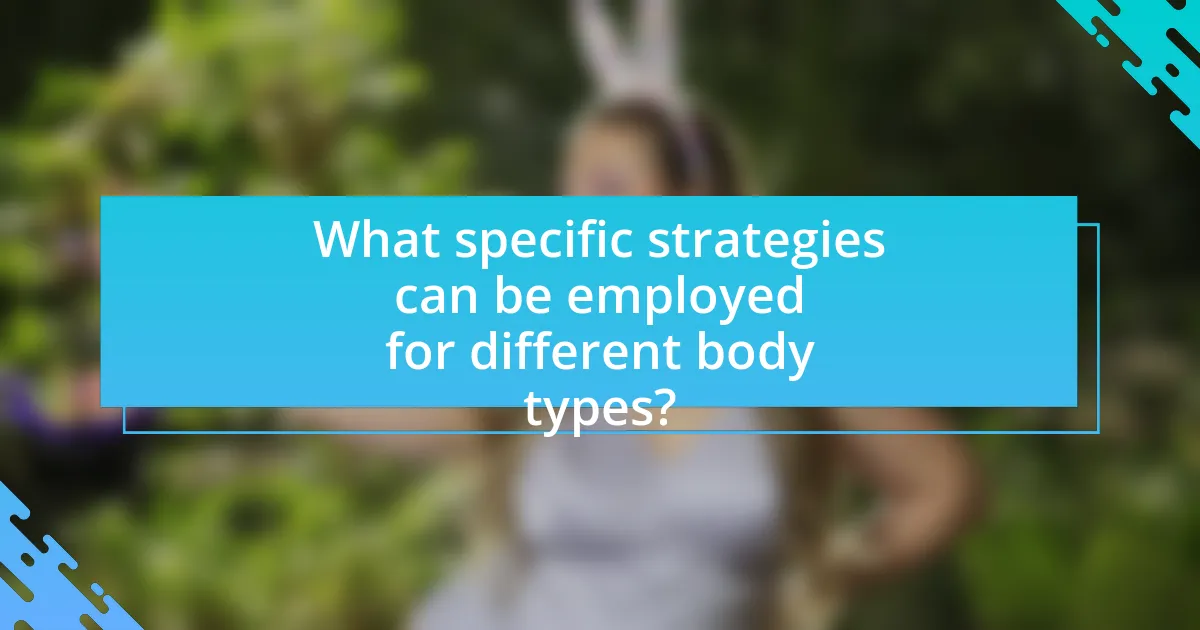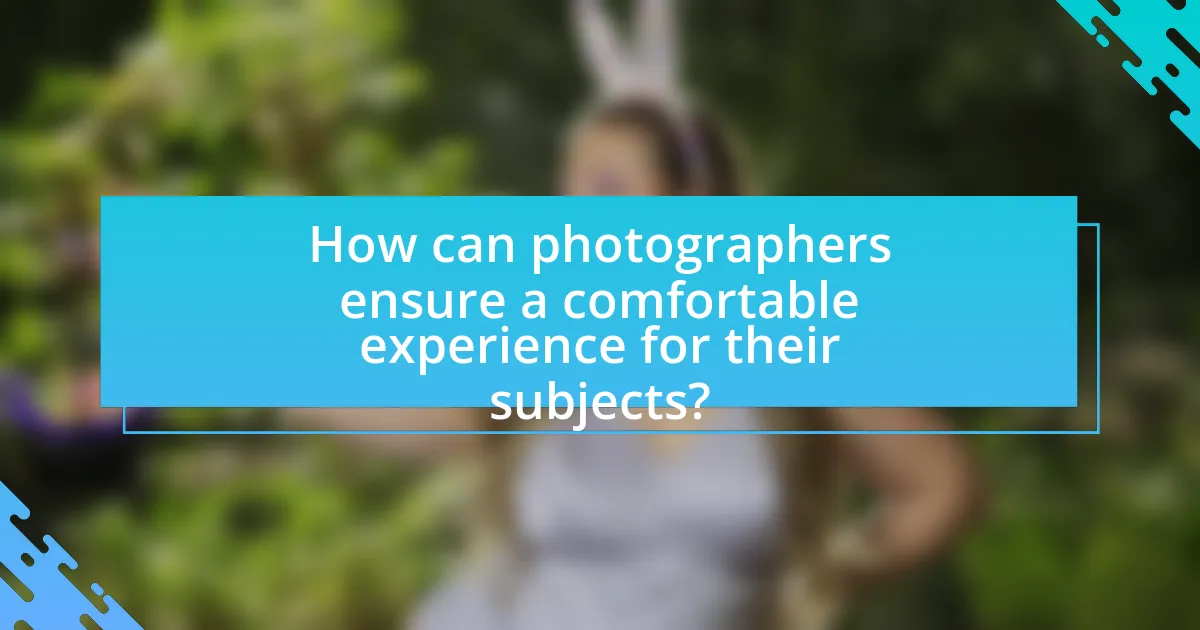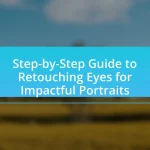The article focuses on “Posing for Different Body Types: Inclusive Strategies for Portrait Photography,” emphasizing the importance of understanding body proportions and employing tailored posing techniques to enhance individual features. It outlines key principles for flattering poses based on common body types, such as apple, pear, and hourglass shapes, and discusses the significance of inclusivity in photography to foster a sense of belonging and improve self-esteem. Additionally, the article provides practical strategies for photographers to create comfortable environments, utilize effective angles, and select appropriate clothing styles that complement diverse body types, ultimately leading to more authentic and appealing portraits.

What are the key principles of posing for different body types in portrait photography?
The key principles of posing for different body types in portrait photography include understanding body proportions, utilizing angles to enhance features, and employing strategic positioning to create flattering silhouettes. Understanding body proportions allows photographers to tailor poses that highlight strengths and minimize perceived weaknesses. For example, individuals with wider hips may benefit from poses that create an S-curve, while those with broader shoulders might look better with poses that draw attention away from the upper body. Utilizing angles, such as shooting from slightly above eye level, can elongate the neck and create a more flattering perspective. Strategic positioning, like placing weight on one leg or using props, can also enhance the overall composition and balance of the portrait. These principles are supported by studies in visual perception, which indicate that specific poses can significantly influence how body types are perceived in photographs.
How can understanding body types enhance portrait photography?
Understanding body types enhances portrait photography by allowing photographers to tailor poses and compositions that flatter individual subjects. By recognizing the unique characteristics of different body types, photographers can create images that highlight strengths and minimize perceived weaknesses, resulting in more authentic and appealing portraits. Research indicates that effective posing can significantly impact the viewer’s perception of the subject’s confidence and attractiveness, as seen in studies on visual aesthetics in photography.
What are the common body types photographers should recognize?
Photographers should recognize three common body types: the apple shape, the pear shape, and the hourglass shape. The apple shape features broader shoulders and a fuller bust with narrower hips, while the pear shape has wider hips and a smaller upper body. The hourglass shape is characterized by a balanced bust and hip measurement with a defined waist. Understanding these body types allows photographers to tailor their posing strategies effectively, enhancing the subject’s features and ensuring a flattering representation in portraits.
How does body shape influence posing techniques?
Body shape significantly influences posing techniques by dictating how subjects are positioned to enhance their natural features and create flattering silhouettes. For instance, individuals with an hourglass figure may benefit from poses that accentuate their waist, while those with a rectangular body shape might use angles and props to create the illusion of curves. Research in portrait photography emphasizes that understanding body proportions allows photographers to tailor poses that highlight strengths and minimize perceived weaknesses, ultimately leading to more appealing images.
Why is inclusivity important in portrait photography?
Inclusivity is important in portrait photography because it ensures that diverse identities and body types are represented and celebrated. This representation fosters a sense of belonging and validation for individuals who may feel marginalized in traditional media. Research indicates that inclusive imagery can positively impact self-esteem and body image, as seen in studies showing that exposure to diverse representations can reduce feelings of inadequacy among viewers. By embracing inclusivity, photographers not only broaden their artistic perspective but also contribute to a more equitable society where all individuals feel seen and valued.
How does inclusivity impact the photographer-subject relationship?
Inclusivity positively impacts the photographer-subject relationship by fostering trust and comfort, which enhances the overall quality of the photographic experience. When photographers embrace inclusivity, they create an environment where subjects feel valued and respected, leading to more authentic expressions and connections during the shoot. Research indicates that inclusive practices, such as acknowledging diverse body types and backgrounds, can significantly improve subjects’ confidence, resulting in more engaging and dynamic portraits. This relationship is further supported by studies showing that when subjects feel represented and understood, they are more likely to collaborate openly with the photographer, ultimately enriching the creative process.
What are the benefits of diverse representation in photography?
Diverse representation in photography enhances authenticity and relatability, allowing a broader audience to see themselves reflected in visual media. This inclusivity fosters a sense of belonging and validation among underrepresented groups, which can lead to increased engagement and emotional connection with the content. Studies show that diverse imagery can improve brand perception and customer loyalty; for instance, a 2019 report by the Geena Davis Institute on Gender in Media found that 67% of women felt more positively about brands that featured diverse representation. Furthermore, diverse representation challenges stereotypes and promotes social change by showcasing a variety of experiences and perspectives, ultimately enriching the narrative within the art form.

What specific strategies can be employed for different body types?
Different body types require tailored posing strategies to enhance their unique features in portrait photography. For example, individuals with an hourglass figure should emphasize their waist by using poses that highlight curves, such as placing one hand on the hip and slightly turning the body to create an S-curve. Conversely, those with a rectangular body type can create the illusion of curves by using poses that involve crossing the legs or arms, which adds dimension.
Research indicates that specific angles and body positioning can significantly impact the perception of body shape in photographs. A study published in the Journal of Visual Communication in Medicine found that poses that accentuate natural body lines can improve the overall aesthetic appeal of portraits. Therefore, employing these strategies based on body type not only enhances individual features but also contributes to more inclusive and flattering portrait photography.
How can photographers adapt poses for various body types?
Photographers can adapt poses for various body types by understanding the unique characteristics of each body type and adjusting angles, positioning, and props accordingly. For instance, photographers can elongate the appearance of shorter body types by using high angles and creating diagonal lines, while emphasizing curves in fuller body types through strategic placement of hands and limbs. Research indicates that poses that create space between body parts can enhance the overall silhouette, making it more flattering regardless of body type. Additionally, using props or environments that complement the subject’s shape can further enhance the visual appeal of the photograph.
What poses work best for curvier body types?
Curvier body types benefit from poses that emphasize curves and create a flattering silhouette. Poses such as the “S-curve” pose, where the subject shifts weight to one leg and creates a gentle curve with their body, highlight natural shapes. Additionally, using angles rather than straight-on shots can enhance the figure; for example, turning the body slightly to the side can create depth and dimension.
Research indicates that poses that incorporate the use of props, such as sitting on a chair or leaning against a wall, can also provide support and enhance comfort, allowing for more natural expressions. These strategies are effective in portrait photography, as they cater to the unique characteristics of curvier body types, ensuring that the final images are both flattering and authentic.
How can photographers create flattering angles for athletic body types?
Photographers can create flattering angles for athletic body types by positioning the camera slightly above eye level and angling it downward. This technique emphasizes the subject’s physique, showcasing muscle definition while minimizing any perceived bulk. Additionally, using dynamic poses that highlight movement, such as twisting the torso or extending limbs, can enhance the athletic form. Research indicates that angles that elongate the body, such as shooting from a lower angle, can also create a more powerful and flattering representation of athletic individuals.
What role does clothing play in posing for different body types?
Clothing plays a crucial role in posing for different body types by enhancing body proportions and creating visual balance. For instance, well-fitted clothing can accentuate curves for individuals with hourglass figures, while structured garments can provide shape for those with rectangular body types. Research indicates that specific styles, such as A-line dresses for pear shapes or tailored suits for athletic builds, can significantly influence how body types are perceived in photographs. This is supported by studies in fashion psychology, which show that clothing choices can affect self-esteem and body image, ultimately impacting the confidence of the subject during a photoshoot.
How can outfit choices enhance or detract from a pose?
Outfit choices can significantly enhance or detract from a pose by influencing the visual impact and overall aesthetic of the photograph. For instance, well-fitted clothing that complements the subject’s body type can create a more flattering silhouette, thereby enhancing the pose. Conversely, ill-fitting or overly busy patterns can distract from the subject’s features and diminish the effectiveness of the pose. Research indicates that colors and textures can also affect perception; for example, solid colors tend to create a more streamlined look, while complex patterns may draw attention away from the subject’s expression and body language. Thus, thoughtful outfit selection is crucial in portrait photography to ensure that the pose is effectively communicated and visually appealing.
What are the best clothing styles for different body types in photography?
The best clothing styles for different body types in photography include tailored outfits for hourglass figures, A-line dresses for pear shapes, structured tops for apple shapes, and straight cuts for rectangular shapes. Tailored outfits enhance curves and create a balanced silhouette for hourglass figures, while A-line dresses draw attention away from the hips for pear shapes. Structured tops add definition to apple shapes, and straight cuts provide a streamlined look for rectangular shapes. These styles are effective because they highlight the body’s natural proportions, ensuring flattering representation in photographs.

How can photographers ensure a comfortable experience for their subjects?
Photographers can ensure a comfortable experience for their subjects by establishing clear communication and creating a welcoming environment. Clear communication involves discussing the subject’s preferences, concerns, and comfort levels before the shoot, which helps to build trust. A welcoming environment can be achieved by choosing a comfortable location, providing adequate breaks, and using positive reinforcement throughout the session. Research indicates that subjects who feel at ease are more likely to express themselves naturally, resulting in better photographs.
What techniques can help subjects feel at ease during a shoot?
To help subjects feel at ease during a shoot, photographers can employ techniques such as establishing rapport, providing clear direction, and creating a comfortable environment. Establishing rapport involves engaging in friendly conversation and making the subject feel valued, which can significantly reduce anxiety. Providing clear direction helps subjects understand what is expected of them, minimizing confusion and self-consciousness. Creating a comfortable environment includes adjusting lighting, temperature, and background noise to suit the subject’s preferences, which can enhance their overall comfort level. These techniques are supported by studies indicating that a positive photographer-subject relationship leads to better outcomes in portrait photography, as subjects are more likely to relax and express themselves authentically.
How can communication improve the posing process?
Effective communication enhances the posing process by fostering a collaborative environment between the photographer and the subject. Clear dialogue allows the photographer to convey specific instructions and feedback, which helps the subject understand how to position themselves for the best results. For instance, studies in visual communication indicate that when subjects receive constructive feedback, they are more likely to feel confident and comfortable, leading to more natural poses. Additionally, open communication enables the photographer to adapt poses based on the subject’s comfort level and body type, ensuring that the final images are both flattering and authentic.
What are some common anxieties subjects face regarding their body types?
Common anxieties subjects face regarding their body types include concerns about body image, perceived flaws, and societal standards of beauty. Many individuals worry about how their body type will be perceived in photographs, fearing that they may not meet the idealized standards often portrayed in media. Research indicates that 70% of individuals experience body dissatisfaction, which can lead to anxiety during photo sessions. This dissatisfaction often stems from comparisons to others and the pressure to conform to specific body ideals, which can significantly impact their confidence and willingness to engage in portrait photography.
What are the best practices for inclusive portrait photography?
The best practices for inclusive portrait photography involve recognizing and celebrating diverse body types, ensuring representation, and creating a comfortable environment for subjects. Photographers should engage in open communication with their subjects to understand their preferences and comfort levels, which fosters trust and authenticity in the portraits. Additionally, using flattering angles and poses that highlight the subject’s unique features can enhance their confidence and the overall image quality. Research indicates that inclusive representation in photography can positively impact self-esteem and body image, making it essential for photographers to prioritize diversity in their work.
How can photographers educate themselves on body positivity?
Photographers can educate themselves on body positivity by actively engaging with resources that promote diverse body representations and understanding the impact of their work on self-image. They can read literature on body positivity, such as “The Body Is Not an Apology” by Sonya Renee Taylor, which emphasizes self-love and acceptance, and follow organizations like the Body Positive or the National Eating Disorders Association that provide educational materials and workshops. Additionally, attending workshops or seminars focused on inclusive photography practices can enhance their skills in portraying individuals of all body types positively. Research indicates that representation in media significantly influences societal standards of beauty, making it crucial for photographers to be informed and sensitive to these issues.
What resources are available for learning about inclusive posing techniques?
Resources for learning about inclusive posing techniques include online courses, workshops, and instructional books focused on portrait photography. Notable platforms such as MasterClass and Skillshare offer courses specifically addressing inclusive posing for diverse body types. Additionally, books like “The Art of Posing: A Guide for Photographers” by J. A. Smith provide practical insights and techniques. Furthermore, photography communities on social media platforms, such as Instagram and Facebook groups, often share tips and experiences related to inclusive posing. These resources collectively enhance understanding and application of inclusive posing techniques in portrait photography.
What practical tips can photographers implement for successful shoots?
Photographers can implement several practical tips for successful shoots, including understanding body types, utilizing flattering angles, and creating a comfortable environment. Understanding body types allows photographers to tailor poses that enhance the subject’s features, ensuring inclusivity and confidence. Utilizing flattering angles, such as shooting from slightly above eye level, can create a more appealing perspective. Creating a comfortable environment fosters trust and relaxation, which leads to more natural expressions and poses. These strategies are supported by studies indicating that comfort and understanding in photography significantly improve the quality of portraits.

















